The Seagate Enterprise Capacity HDD v3 is a 2.5” drive is Seagate’s third generation of Enterprise Capacity drives, this time with the highest capacity currently available for 2.5” HDDs at 2TB (Toshiba has a 3TB 2.5” HDD but it is not currently available). The drive also comes in 1TB, 500GB and 250GB capacities. The drive is available in either 12Gb/s SAS or 6Gb/s SATA. And for users looking for an extra secure solution, the Seagate Enterprise Capacity HDDs come in Self Encrypting Models (SED) with Secure Erase technology and come in a government-grade SED FIPS 140-2 models.
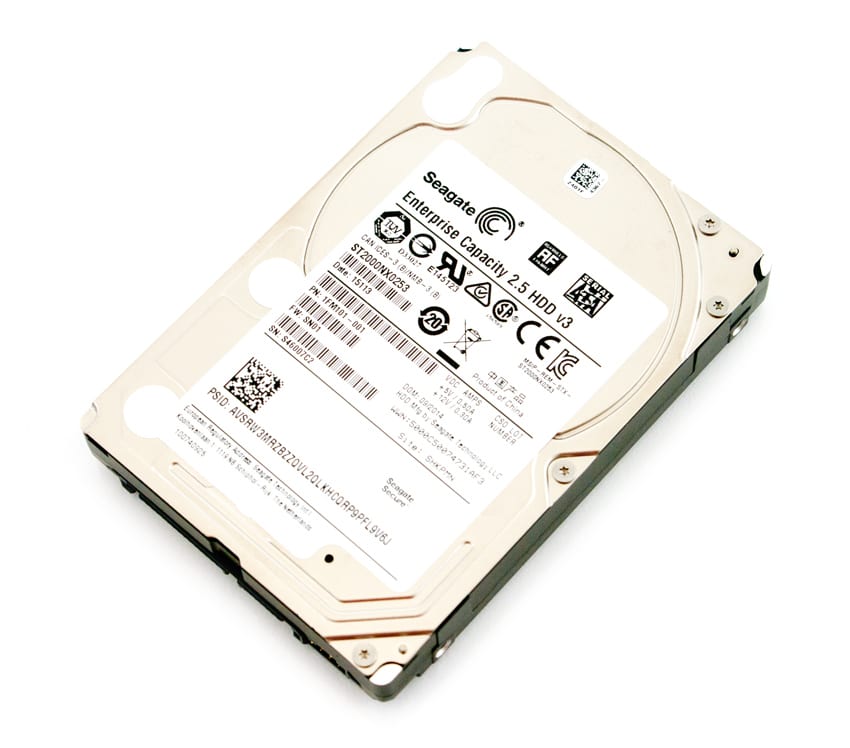
The third generation of the Seagate Enterprise Capacity HDD 2.5” comes with twice the maximum capacity over the previous generation, a 50% improvement in watts/TB and an 18% improvement in sequential performance. Being a 2.5” drive, it can save both on energy costs and on space in a data center looking for maximum density with minimal footprint. Seagate was also able to improve rotational vibration tolerance and added head micro-actuation giving the drive maximum system availability and performance. The drive is ideal for businesses that need large amounts of storage, rich media content, enterprise backup, and cloud computing.
The Seagate Enterprise Capacity 2TB 2.5” HDD v3 comes with a 5-year limited warranty and has a street price of $385. For our review we will be looking at the SATA version.
Seagate Enterprise Capacity 2TB 2.5” HDD v3 specifications:
- Model: ST2000NX0253
- Spindle Speed (RPM): 7,200
- Average Latency (ms): 4.16
- Sustained Transfer Rate (MB/s): 136
- Cache buffer, Multi-segmented (MB): 128
- Configuration/Reliability
- Disks: 5
- Heads: 10
- Interface: SATA 6Gb/s
- Internal data transfer rate (Mb/s): 2,160
- Non-recoverable Read Errors per Bits Read: 1 per 10E15
- Annualized Failure Rate (AFR): 0.44%
- Power Management
- Typical Op (A) +5V/+12V: 0.30/0.31
- Typical Operating (W): 5.22
- Power Idle (W): 4.12
- Performance Efficiency Index (Idle W/GB): 0.002
- Temperature, Operating (°C): 5 to 55
- Shock, Operating: 2ms (Gs): 25
- Shock, Non-operating: 2ms (Gs): 400
- Acoustics Idle (bels—sound power): 3.2
- Vibration, Operating: <500Hz (Gs): 0.5
- Vibration, Non-operating: <500Hz (Gs): 3.0
- Physical
- Height (in/mm, max): 0.591/15.00
- Width (in/mm, max): 2.760/70.10
- Depth (in/mm, max): 3.955/100.45
- Weight (lb/kg): 0.437/0.198
- Carton Unit Quantity: 30
- Cartons per Pallet: 50
- Cartons per Layer: 10
- Limited Warranty: 5-years
Design and build
The Seagate Enterprise Capacity 2TB HDD v3 is a 2.5″ form factor drive with a height of 15mm. Most of Seagate’s 2.5” HDDs look very similar on the outside, the main difference being the label. The top features the product information label with the related specs such as capacity and interface. The sides of the drive provide four screw holes for simple mounting. The bottom of the drive has the circuit board exposed.
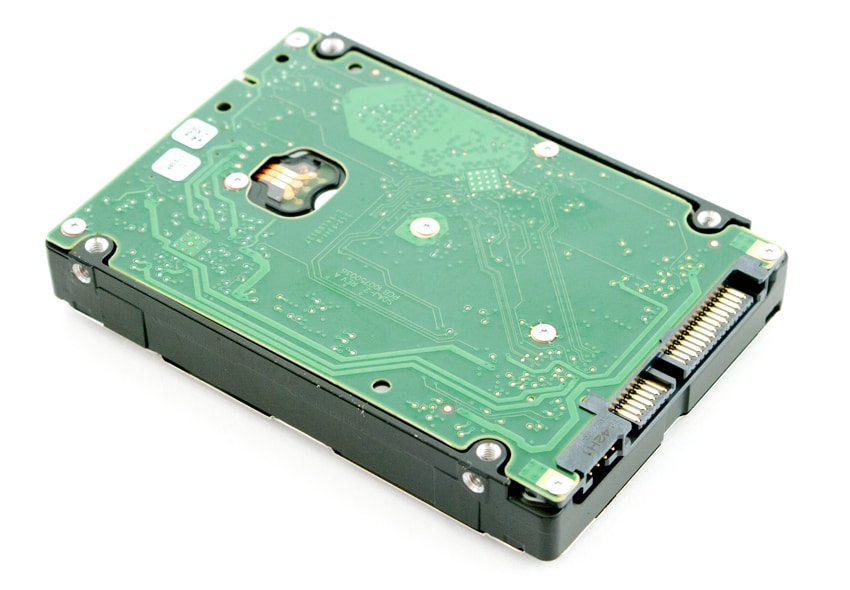
The front of the drive features a traditional SATA interface.
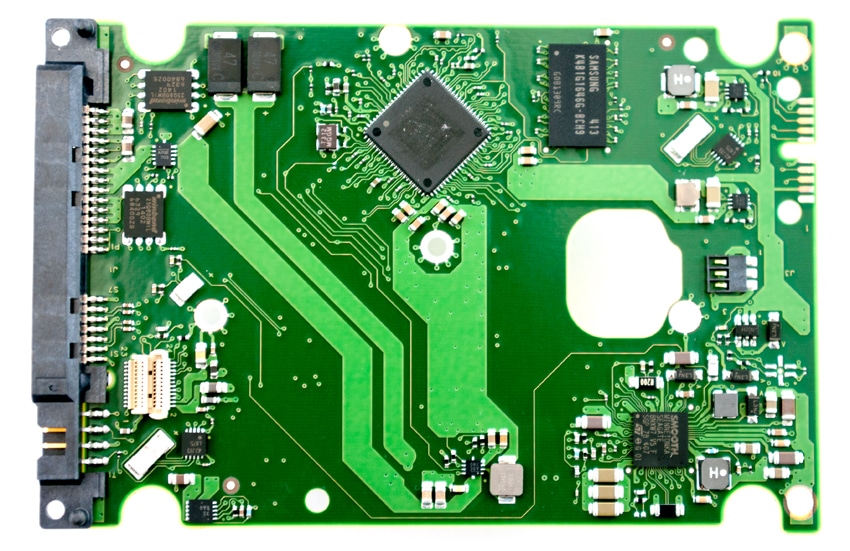
Inside the Seagate Enterprise Capacity 2TB HDD v3, the primary controller is an LSI model with a Samsung DRAM package visible.
Testing Background and Comparables
We will be comparing the Enterprise Capacity 2TB HDD v3 with the Seagate Enterprise Performance 10Kv8 1.8TB. The Performance 10K v8 SAS model was tested in the Dot Hill AssuredSAN 4824 while the Capacity 2TB SATA version was tested in Windows Storage Spaces using a Supermicro SuperStorage Server 2027R-AR24NV chassis. While this comparison isn’t perfectly apples to apples, it does help put some light on performance numbers.
Enterprise Synthetic Workload Analysis
Prior to initiating each of the fio synthetic benchmarks, our lab preconditions the device into steady-state under a heavy load of 16 threads with an outstanding queue of 16 per thread. Then the storage is tested in set intervals with multiple thread/queue depth profiles to show performance under light and heavy usage. Preconditioning and Primary Steady-State Tests:
- Throughput (Read+Write IOPS Aggregate)
- Average Latency (Read+Write Latency Averaged Together)
- Max Latency (Peak Read or Write Latency)
- Latency Standard Deviation (Read+Write Standard Deviation Averaged Together)
Our condensed Enterprise Synthetic Workload Analysis includes one profiles designed to show peak random I/O from each device. This profile is designed to be used as a baseline comparable to cross-reference manufacturer claims of random transfer speeds.
- 4k
- 100% Read or 100% Write
- 100% 4k
- 8k (Sequential)
- 100% Read or 100% Write
- 100% 8k
- 8K 70/30
- 70% Read, 30% Write
- 100% 8K
- 128K (Sequential)
- 100% Read or 100% Write
- 100% 128K
In our 100% 4K random read and write test, the Capacity drive had a throughput performance of 7,293 IOPS read and 3,644 IOPS write. The performance drive was unsurprisingly a better performer with 10,971 IOPS read and 7,127 IOPS write.
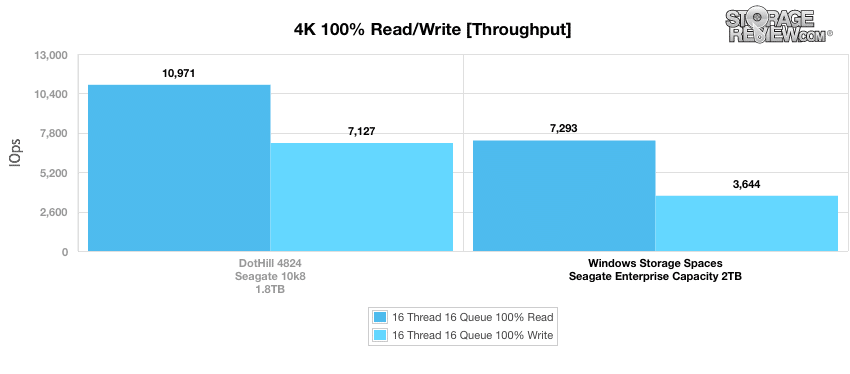
When looking at average latency, Capacity drive had a latency of 35.09ms read and 70.24ms write. The Performance gave us a read latency of 23.33ms and a write latency of 35.91ms.
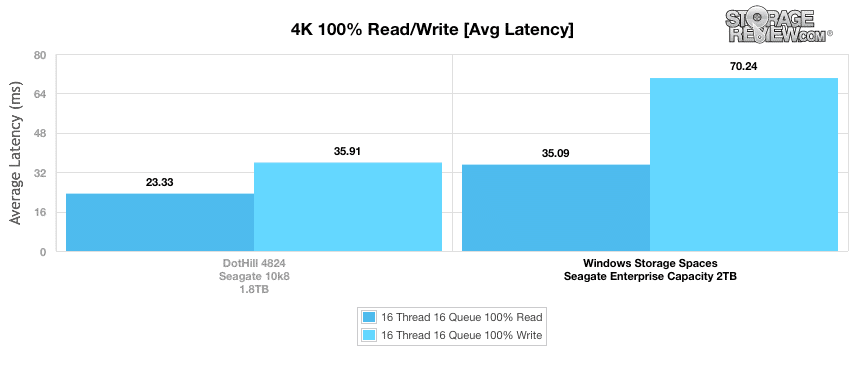
Moving to max latency, we see the Capacity came out on top with the best write latency of 1,988.3ms. Its read latency was1,077.4ms. The Performance had latencies of 498.7ms read and 2,437.2ms write.
Standard deviation showed no real surprises with the Capacity drive having latencies of 41.73ms read and 91.22ms write while the Performance drive had 25.26ms read and 35.69ms write.
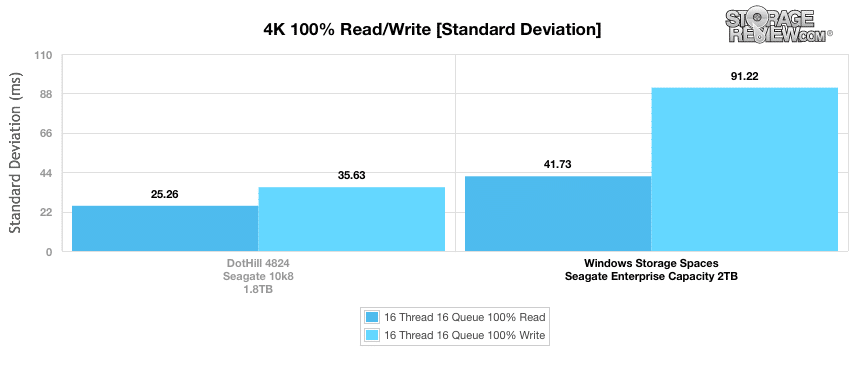
The next test again puts the drives under 100% read/write activity, this time at 8K sequential throughput. The Capacity drive gave as a throughput performance of 102,821 IOPS read and 4,707 IOPS write and the Performance drive gave us 130,537 IOPS read and 54,306 write.
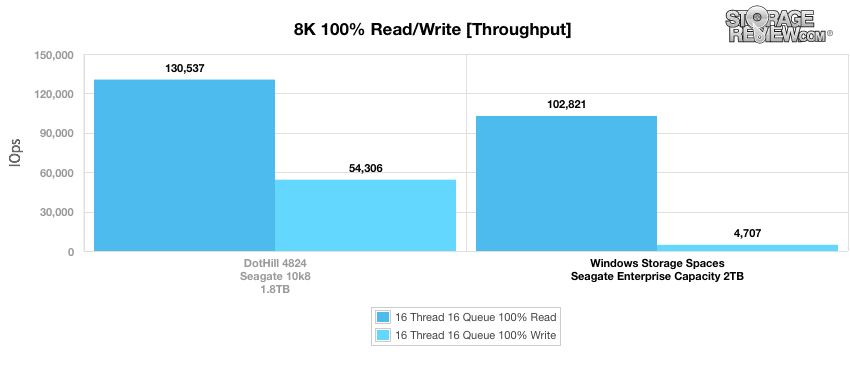
Compared to the fixed 16 thread, 16 queue max workload we performed in the 100% 4k write test, our mixed workload profiles scale the performance across a wide range of thread/queue combinations. In these tests, we span workload intensity from 2 threads and 2 queue up to 16 threads and 16 queue. In throughput, the results were as expected with the Performance drive coming out on top throughout the test. The Capacity drive peaked at 5,727 IOPS.
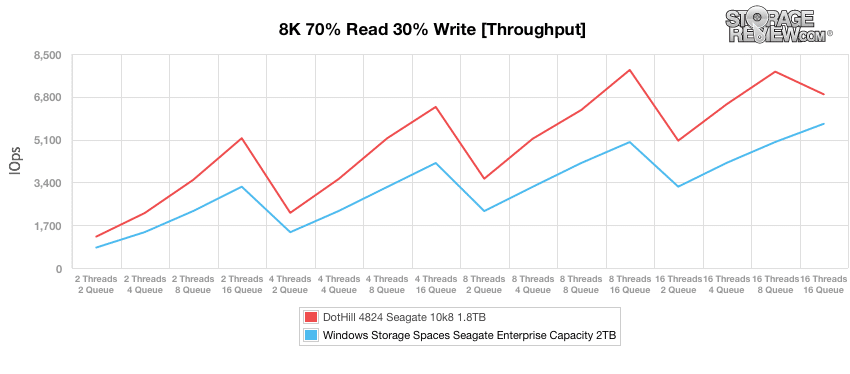
Average latency painted a similar picture with the Capacity trailing the Performance throughout.
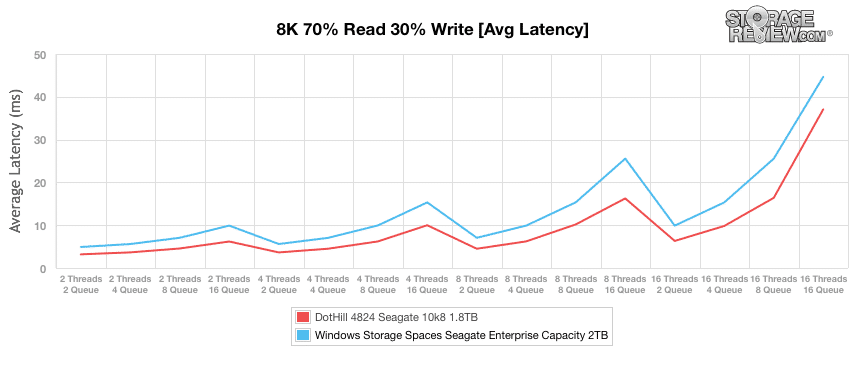
With max latency, the Capacity drive started off much higher before falling more inline with the Performance drive.
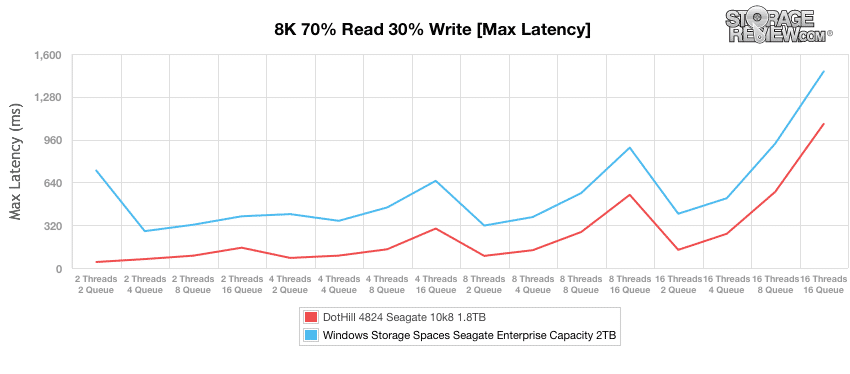
With standard deviation, we actually see the Capacity drive performed better than the Performance drive in the terminal depth, however the Performance maintained a much lower latency throughout.
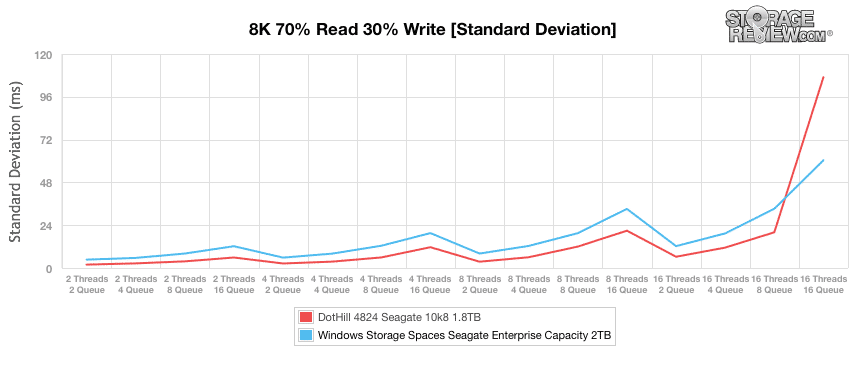
Our Enterprise Synthetic Workload 128K test is a large block sequential test that shows the highest sequential transfer speed for a platter drive. When looking at 128K performance of 100% write and 100% read activity, the Capacity drive had speeds of 256MB/s write and 1.41GB/s read. The Performance drive had a read and write speed of 2.46GB/s.
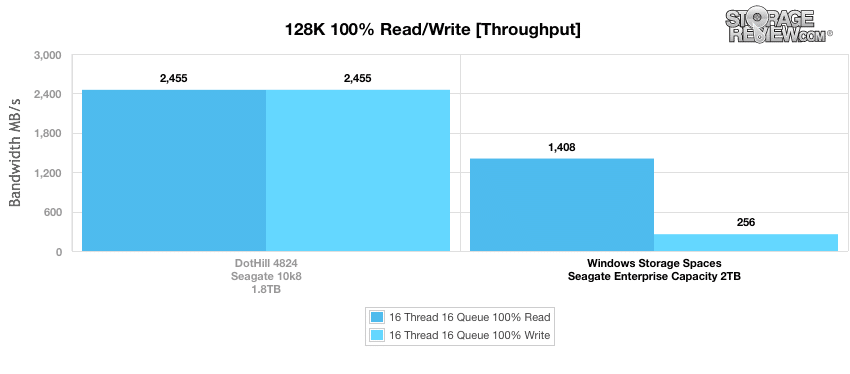
Conclusion
The third generation Seagate Enterprise Capacity is a 2.5” HDD that is ideal for data centers looking to expand their capacity while keeping their footprint as small as possible. The drive has a maximum capacity of 2TB (though there is a 1TB, 500GB, and even a 250GB model offered). Seagate claims better performance over the previous generation in part through improvements in rotational vibration tolerance and head micro-actuation. The drives also offer flexibility in choice as they come with either 12Gb/s SAS or 6Gb/s SATA interface and the security options of either a SED with Secure Erase technology or a SED FIPS 140-2 model.
Performance for this review can be a bit misleading at first. The Seagate Enterprise Capacity HDD v3 is now shipping as the highest capacity 2.5” HDD at 2TB. Unfortunately we didn’t have much to compare the drive to for an “apple to apple” comparison. We chose the Seagate Enterprise Performance drive for two reasons: the capacity was relatively close (1.8TB to 2TB) and the comparison gives buyers an idea of how the Capacity drives stacks up against a drive built for performance. It comes as no surprise that the Performance drive beats out the Capacity drive on every test, however we did illustrate how well the drive performs.
In our 4K tests the Seagate Enterprise Capacity HDD v3 showed a throughput of 7,293 IOPS read and 3,644 IOPS write and an average latency of 35.09ms read and 70.24ms write. In our 8K sequential the Capacity drive showed a throughput of 102,821 IOPS read and 4,707 IOPS write. And our large block sequential test showed us speed of 1.41GB/s read and 256MB/s write.
Pros
- Largest capacity 2.5” HDD currently on the market
- Secure erase feature along with SED FIPS 140-2 models available
- About half the price of its Performance counterpart
Cons
- Trades price/power consumption for performance
The Bottom Line
The Seagate Enterprise Capacity HDD v3 is the highest capacity 2.5” drive currently shipping, giving data centers much more capacity and density with a much lower footprint.
Discuss this review


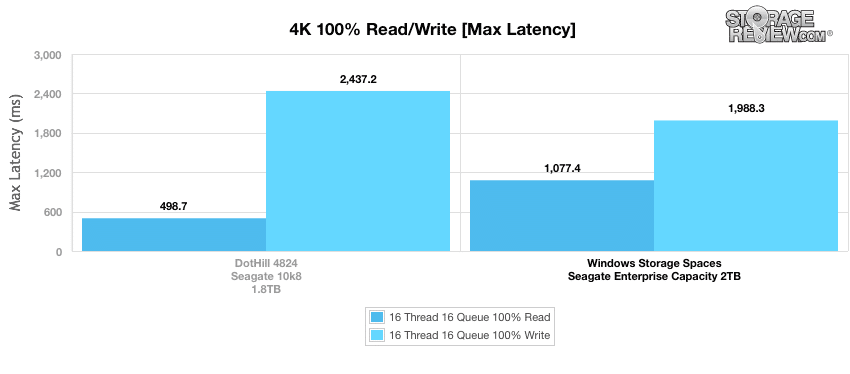


 Amazon
Amazon